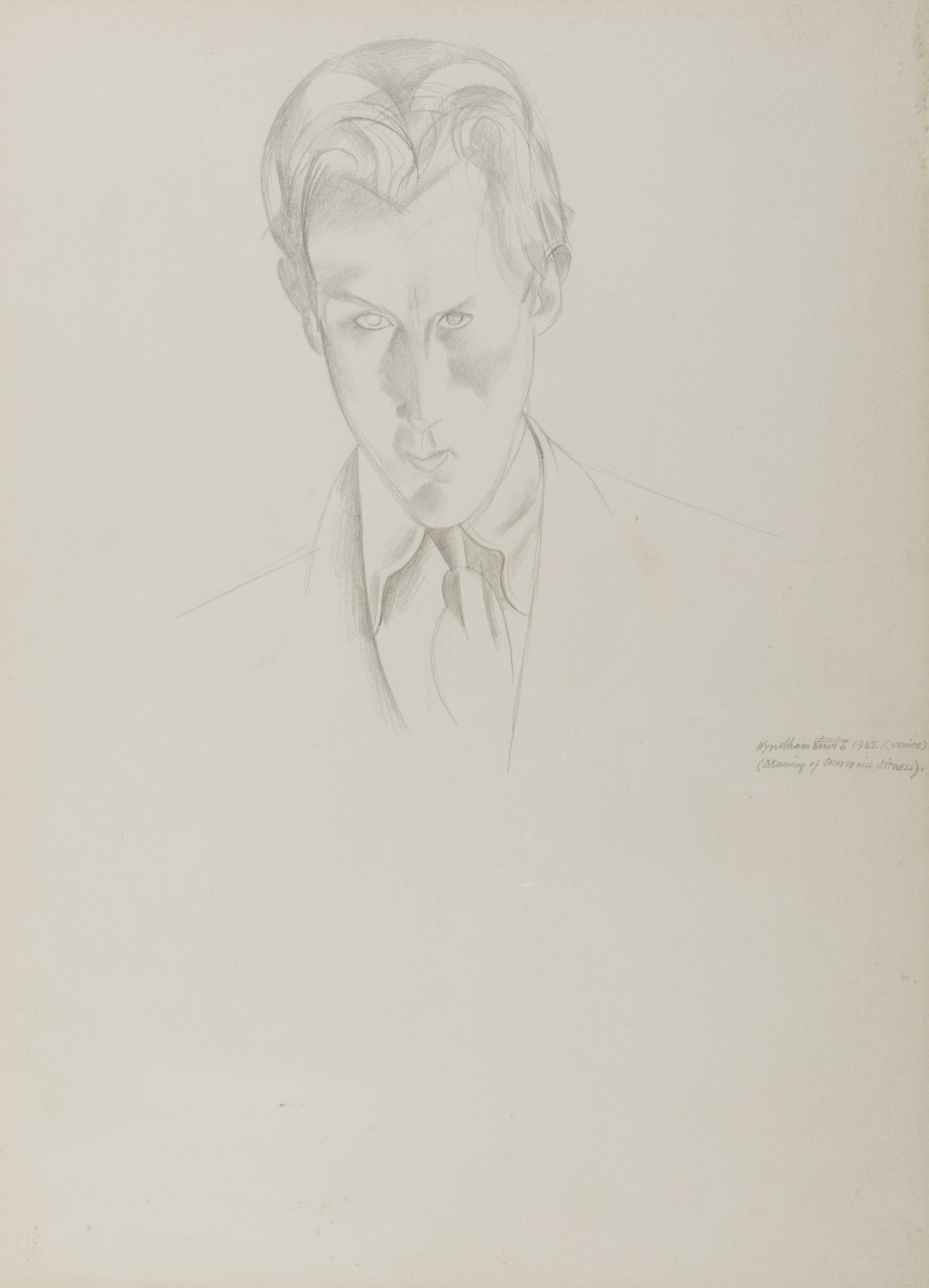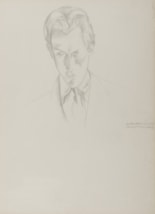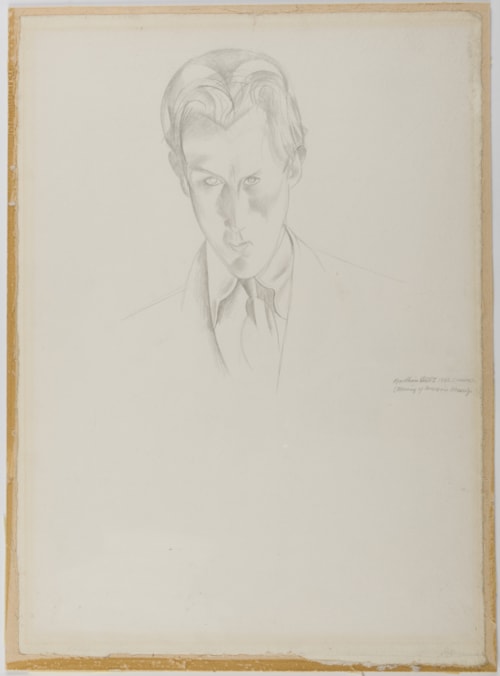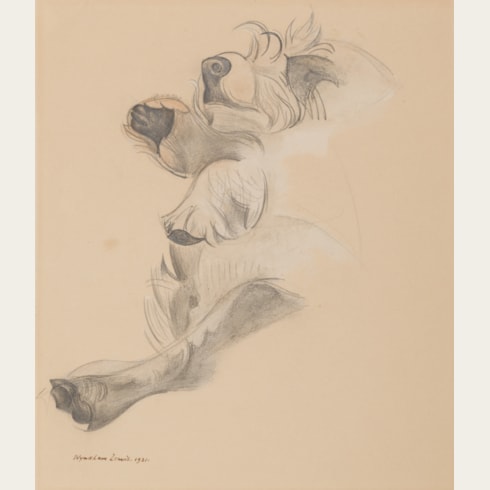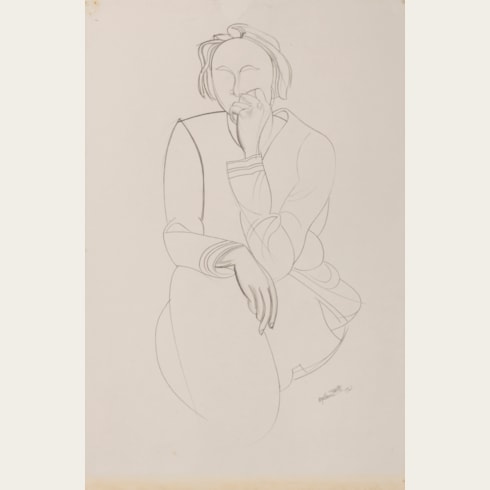Wyndham LEWIS
(Amherst, Nova Scotia 1882 - London 1957)
Portrait of Sacheverell Sitwell
Sold
Pencil on paper, laid down.
Signed, titled, dated and inscribed Wyndham Lewis 1922. (VENICE). / (Drawing of SACHEVERILL [sic] SITWELL). at the left centre.
392 x 282 mm. (15 3/8 x 11 1/8 in.)
Signed, titled, dated and inscribed Wyndham Lewis 1922. (VENICE). / (Drawing of SACHEVERILL [sic] SITWELL). at the left centre.
392 x 282 mm. (15 3/8 x 11 1/8 in.)
A poet, author and art and music critic, Sir Sacheverell Reresby Sitwell, 6th Bt. (1897-1988) was the youngest of the three equally brilliant and intriguing Sitwell siblings, alongside his sister Edith and brother Osbert. An admirer of Wyndham Lewis’s Blast magazine while still a student at Eton, Sacheverell soon came to befriend the artist. Following a visit to Paris in the spring of 1919, he had planned to mount an exhibition of the work of Lewis and other Vorticists in Paris, although this never seems to have come to fruition. Lewis produced a handful of drawings of all three Sitwells - of whom, he noted, Sacheverell was ‘quite the nicest’ – as well as a painted portrait of Edith, although in his later writings he ridiculed the pretentiousness of the siblings.
The present sheet was drawn when Osbert and Sacheverell Sitwell were in Venice in the late autumn of 1922. Lewis, who earlier in the year had been a guest of the Sitwells at Renishaw Hall in Derbyshire, was also in Venice, with his sometime lover Nancy Cunard. As Lewis later recalled, ‘Osbert and Sacheverell were both there…Sacheverell with the look of sedate alarm which at that period was characteristic of him.’ While in Venice Lewis also produced an unfinished drawing of the Sitwell brothers, now in a private collection, which may have been a compositional study for a planned - though never executed - double portrait. The present sheet may, in fact, have been a secondary study for the head of Sacheverell in the double portrait, in which it is left unresolved; certainly, the angle of the sitter’s head in both this drawing and the portrait drawing of the two brothers is nearly identical.
Lewis drew at least one other, earlier portrait of Sacheverell Sitwell, which was exhibited in London in April 1921.
The present sheet was drawn when Osbert and Sacheverell Sitwell were in Venice in the late autumn of 1922. Lewis, who earlier in the year had been a guest of the Sitwells at Renishaw Hall in Derbyshire, was also in Venice, with his sometime lover Nancy Cunard. As Lewis later recalled, ‘Osbert and Sacheverell were both there…Sacheverell with the look of sedate alarm which at that period was characteristic of him.’ While in Venice Lewis also produced an unfinished drawing of the Sitwell brothers, now in a private collection, which may have been a compositional study for a planned - though never executed - double portrait. The present sheet may, in fact, have been a secondary study for the head of Sacheverell in the double portrait, in which it is left unresolved; certainly, the angle of the sitter’s head in both this drawing and the portrait drawing of the two brothers is nearly identical.
Lewis drew at least one other, earlier portrait of Sacheverell Sitwell, which was exhibited in London in April 1921.
One of the most significant figures of the avant-garde in Britain in the first half of the 20th century, Percy Wyndham Lewis was unusual among his contemporaries in that he was highly regarded as both a writer and an artist. As he noted in one autobiographical account, ‘I am a novelist, painter, sculptor, philosopher, draughtsman, critic, politician, journalist, essayist, pamphleteer, all rolled into one, like one of those portmanteau-men of the Italian Renaissance.’ A student at the Slade School of Art in London between 1898 and 1901, Lewis spent the next seven years in Europe, mainly in Paris but also studying in Madrid, Haarlem and Munich. Returning to England in 1908, he exhibited from 1911 onwards with the artists of the Camden Town Group and at the Allied Artists’ Association, and was also included in Roger Fry’s Second Post-Impressionist Exhibition at the Grafton Galleries in 1912. Lewis joined Fry’s Omega Workshops in 1913, but by the following year had left to establish the Rebel Art Centre and the magazine Blast, which first appeared in June 1914 and became the manifesto of the short-lived movement known as Vorticism. Lewis was one of the leaders of the Vorticist movement – a group which also included the much younger artists Edward Wadsworth and William Roberts - and was the author of most of the theoretical writings associated with the group. While Vorticism flourished for only a brief period, Lewis continued to work as an artist during and after his military service in the First World War.
Around a thousand drawings and a hundred paintings by Lewis are known. Immensely gifted as both artist and writer, for most of his career he worked as both concurrently, although by the early 1920s it was his writing that began to take up much of his creative energy. As he recalled in later years, ‘From 1924 onwards writing became so much of a major interest that that I have tended to work at my painting or drawing in prolonged bursts, rather than fit them into the intervals of the planning or writing of books. Writing and picture-making are not activities, I have found, which mix very well, unless one becomes the servant of the other as was the case with Blake, or with Rossetti.’ Nevertheless, he produced a significant group of paintings and drawings throughout the 1930s, much of which was shown in one-man exhibitions at various galleries in London. Lewis spent the years of the Second World War in America and Canada, but within a few years of his return to London in 1945 had begun to lose his sight and largely stopped painting, becoming completely blind by 1951.
Wyndham Lewis’s output as a draughtsman was of considerable importance in his oeuvre. Apart from publishing three separate portfolios of his drawings - in 1913, 1919 and 1932 - Lewis frequently used his drawings to illustrate the numerous books, pamphlets and articles he produced. He included significant numbers of drawings in his gallery exhibitions, and in his submissions to such group shows as Roger Fry’s Second Post-Impressionist exhibition of 1912 and the first Vorticist group exhibition in 1915. Furthermore, as one recent scholar has noted, at times ‘drawing functioned, in a sense, as painting for Lewis...The drawings stand as substitutes for paintings when means, materials or the creative will was not there, or at times when Lewis was so taken up with his written work, as in much of the 1920s and ‘30s, that more significant production would have been unfeasible.’
Around a thousand drawings and a hundred paintings by Lewis are known. Immensely gifted as both artist and writer, for most of his career he worked as both concurrently, although by the early 1920s it was his writing that began to take up much of his creative energy. As he recalled in later years, ‘From 1924 onwards writing became so much of a major interest that that I have tended to work at my painting or drawing in prolonged bursts, rather than fit them into the intervals of the planning or writing of books. Writing and picture-making are not activities, I have found, which mix very well, unless one becomes the servant of the other as was the case with Blake, or with Rossetti.’ Nevertheless, he produced a significant group of paintings and drawings throughout the 1930s, much of which was shown in one-man exhibitions at various galleries in London. Lewis spent the years of the Second World War in America and Canada, but within a few years of his return to London in 1945 had begun to lose his sight and largely stopped painting, becoming completely blind by 1951.
Wyndham Lewis’s output as a draughtsman was of considerable importance in his oeuvre. Apart from publishing three separate portfolios of his drawings - in 1913, 1919 and 1932 - Lewis frequently used his drawings to illustrate the numerous books, pamphlets and articles he produced. He included significant numbers of drawings in his gallery exhibitions, and in his submissions to such group shows as Roger Fry’s Second Post-Impressionist exhibition of 1912 and the first Vorticist group exhibition in 1915. Furthermore, as one recent scholar has noted, at times ‘drawing functioned, in a sense, as painting for Lewis...The drawings stand as substitutes for paintings when means, materials or the creative will was not there, or at times when Lewis was so taken up with his written work, as in much of the 1920s and ‘30s, that more significant production would have been unfeasible.’
Provenance
Sir Sacheverell Sitwell, Weston Hall, Weston, Northamptonshire
His son, Francis Trajan Sitwell, Weston Hall, Northamptonshire
Thence by descent in the Sitwell family at Weston Hall, Northamptonshire, until 2021.
His son, Francis Trajan Sitwell, Weston Hall, Northamptonshire
Thence by descent in the Sitwell family at Weston Hall, Northamptonshire, until 2021.
Literature
John Lehmann, A Nest of Tigers: Edith, Osbert and Sacheverell Sitwell in their times, London, 1968, illustrated facing p.22; Walter Michel, Wyndham Lewis: Paintings and Drawings, Berkeley and Los Angeles, 1971, p.384, no.554, illustrated pl.59; Sarah Bradford, Sacheverell Sitwell: Splendours and Miseries, London, 1993, pp.117 and 430; Sarah Bradford et al, The Sitwells and the Arts of the 1920s and 1930s, exhibition catalogue, London, 1994-1995, p.102, under no.3.32, pp.194 and 202, no.6.1; Paul Edwards, Wyndham Lewis: Painter and Writer, New Haven and London, 2000, p.252; Paul Edwards and Richard Humphreys, Wyndham Lewis Portraits, exhibition catalogue, London, 2008, illustrated p.52.
Exhibition
London, National Portrait Gallery, The Sitwells and the Arts of the 1920s and 1930s, 1994-1995, no.6.1; London, National Portrait Gallery, Wyndham Lewis Portraits, 2008, unnumbered.

